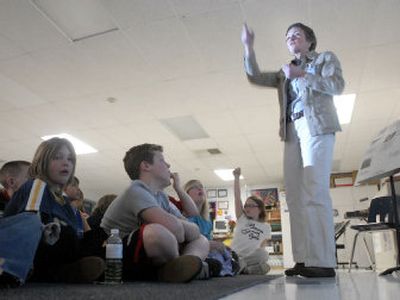Research project connects street names to city’s past

POST FALLS – Kim Brown is on a journey to create a permanent map of the past that will help preserve the history of Post Falls and the surrounding area via the Post Falls Historical Society’s “Place Name” project.
A 30-year Post Falls resident, Brown became involved in the project two years ago because she is concerned that much of community’s history is being lost along with the open expanses of farmland that once surrounded the town. Freshly paved streets, encircling fences and rows of new houses are fast filling that land.
Brown has long had a deep interest in the history of the town and its people. She has served as president of the Post Falls Historical Society, is chairman of the Kootenai County Historical Society and serves in an advisory capacity on the Kootenai County Planning Commission – all volunteer positions.
She believes one key to preserving regional history is to research names already attached to streets and roads and find out how the names came to be – why a particular road or street has a particular name. Recording original, family ownership of farm land that now is being subdivided and turned into housing developments, is another way of preserving history through names.
She says, “I would rather see streets have names that have a connection to the history and people of the area than the cookie-cutter, made-up names given to new streets and communities by those who are unaware of local history.”
She believes that if historic information were available in a database, perhaps developers could be encouraged to use that base and would choose these historical names rather than something like Gingerbread Lane that sounds nice but has no local significance.
She points out that there are already some streets with a historical connect, mentioning Seltice Way, Spokane Street, and Mullan Avenue. Seltice was the name of an Indian Chief, Spokane commemorates the tribe of Indians, and Mullan refers to John Mullan, who laid out the original military road that ran from Walla Walla to Fort Benton.
And of course, the name of the town of Post Falls itself, named after Frederick Post, who established a saw mill there on the Spokane River, is an easily identifiable part of history. An obvious choice in road naming is Poleline Avenue, named for the power poles and lines that stretch in a straight line from west to east across the Rathdrum Prairie.
Brown says, “Renaming existing streets with historical names could recall people, places or events. Many old-timers remember the names of early families such as Schilling, Chase and Millsap and with the rapid development along Seltice Way and Mullan Avenue, the Brugger and Boston family names should remain a part of the town and not be lost. Several generations of these families remain.”
She also believes that when a new park is created, the story of the land should be considered. Q’emiln Park along the River is a good example of this. It is an important part of the region’s history.
She says that there is a proposed park under consideration which would be near the junction of three railroads at Poleline Avenue and that this junction is the reason for the jog in Poleline. Railroads are such an important part of local history.
An appropriate name could recall the original history of that significance.
She emphasizes that the research has been a fun project and full of surprises. She wonders how many people might know that builder, Ken Johnson, named Tammy Street for his eldest daughter or that he bestowed the name Monarch Drive on the street in honor of his beloved, 1949 Ford Monarch.
“Then there is Pamela Drive, named for Post Falls resident, Pam Love,” says Brown. “Or Herborn Place. Herborn, Hesse, Germany, was the birthplace of Fredrick Post, a fact that came to light during research done in the eighties and used to develop the Associate City Project with the German town.”
Another story Brown tells is that of Bill Wilson, who befriended neighbors, and many people today remember him fondly from their childhoods. “People feel connected to the past through these names. It’s a human essence thing.”
Brown’s hope is that the community at large will join in this research project and is inviting people to call her with any information they might have about early day events, contributing citizens, schools, railroads – anything that has to do with the history of Post Falls, the surrounding suburbs and farmland. She particularly would like to hear from seniors who have lived in the area for a long time.
“There is a community effect if we share,” she says. “Everyone knows a little bit about everything.”